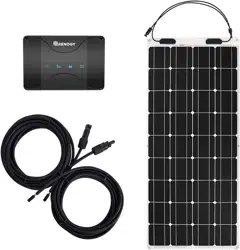Loading ...
Loading ...
Loading ...

22
Battery Charging Parameters
NOTE
Battery Type GEL FLOODED
Over-voltage Warning
16 V 16 V
Charging Limit Voltage
Over-voltage Recover
15.5 V15.5 V
Boost Charge Voltage
Float Charge Voltage
Boost Return Voltage
Over-discharge Recover
Equalization Voltage
----- -----
----- -----
-----
14.8 V
14.6 V 14.6 V 14.4 V
13.8 V 13.8 V
13.2 V13.2 V
12.6 V 12.6 V
SEALED/AGM
16 V
15.5 V
14.2 V
13.8 V
13.2 V
12.6 V
LI (LFP)
16 V
15 V 15 V15 V 15 V
15.5 V
-----
-----
-----
----------
13.2 V
12.6 V
Under Voltage Recover
12.2V
12.2V12.2V
12.3V
11.1V
11.1V11.1V
11.1V
12V
12V12V
12.1V
Under Voltage Warning
Over-discharge Warning
2 hours
Equalization Duration
-----
USER
9~17V
9~17V
9~17V
9~17V
9~17V
9~17V
9~17V
9~17V
9~17V
9~17V
9~17V
0-30 Days
0-120min
0-120min
2 hours2 hours 2 hours
28 days
Boost Duration
Equalization interval
User mode is an extra feature accessed via App or Monitoring Screen; Future Development
This equipment has been tested and found to comply with the limits for a class B digital device,
pursuant to part 15 of the FCC Rules. These limits are designed to provide reasonable
protection against harmful interference in a residential installation. This equipment generates,
uses and can radiate radio frequency energy and if not installed and used in accordance with
the instructions, may cause harmful interference to radio communications. However, there is no
guarantee that interference will not occur in a particular installation. If this equipment does
cause harmful interference to radio or television reception, which can be determined by turning
the equipment off and on, the user is encouraged to try to correct the interference by one or
more of the following measures:
This device complies with Part 15 of the FCC Rules. Operation is subject to the following two
conditions: (1) this device may not cause harmful interference, and (2) this device must accept
any interference received, including interference that may cause undesired operation.
Reorient or relocate the receiving antenna.
Increase the separation between the equipment and receiver.
Connect the equipment into an outlet on a circuit different from that to which the receiver is
connected.
Consult the dealer or an experienced radio/TV technician for help.
Loading ...
